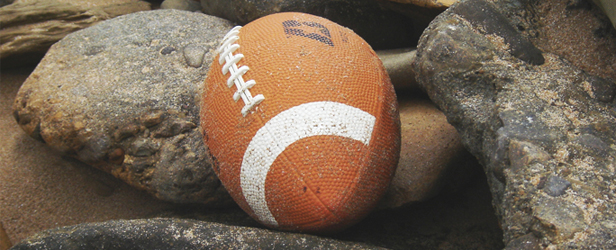
Don’t let the 2012 season hold back your development for 2013.
The holiday season fading from view in the rearview mirror can only mean one thing—the 2012 football season is over. It’d be very easy for an athlete to just sit back and rest on his laurels for a bit. After all, football is a grind from start to finish, no matter what level you’re currently playing at. Make no mistake about it, though—how an athlete handles the first few months after this season WILL have a direct effect on his performance next fall. So don’t let this period of time dictate how he’ll play in 2013. I’ve written five simple steps to help get your football off-season moving in the right direction, and the emphasis really is on simplicity. In my experience with training athletes (from youths on up to the professional level), very few want to know every detail or nuance of training. Instead, just give ‘em the nuts and bolts that’ll help them dominate the competition, and they’ll trust you with their careers for their entirety.
1. Get Healthy.
As I stated previously, football is a grind. Starting with training camp in the summer and then rolling through the season, training, practicing, and competing on a regular basis will take both a physical and mental toll on an athlete. It’s absolutely imperative that athletes take an ACTIVE roll in getting healthy in the weeks immediately following the season. The emphasis on ‘active’ is crucial. They can’t take a month or two completely off and expect to pick up where they left off. At the NFL level, every player will have an exit physical with their team, so start ingraining a “professional mindset” in your athletes now. Obviously major injuries need to be addressed with physicians, but minor injuries need to be treated now, too. Anything that’s been nagging a player through the season, or anything that he has been battling through, should be addressed immediately.
2. MOVE!
December hits and guys go into hibernation. Without the structure of practice or training, football players around the country tend to fall into the routine of school-friends-home-repeat during the winter months. If they’re not committed to a winter sport, set up a routine that they can stick with ASAP. Rest is an important piece of the puzzle during this time of year, but that doesn’t mean a complete absence of training. Depending on the level/position of the athlete, getting three to four days a week in the gym and on the field for some simple workouts will go a very long way in setting the tone for 2013.
3. Lower the Stress...
I’m talking physical stress here, not just mental stress. Lifting heavy, sprinting, and jumping are very important components in the annual plan of a football player, but they’re also high-stress activities that demand adequate recovery. The two to four weeks immediately following the season are a time to cut back on these activities so that the body truly has a chance to recover from the rigors of the season. Once again, though, this does not mean an absence of training. Cut way back on the volume/intensity of any jumping; control the output of sprinting by focusing on tempo runs, hill runs, or beach runs (if possible); and shift the focus in the weight room. This is one time during the year when I’m a strong believer in backing off a little bit in the gym—keep the intensity and volume of the main lifts in the “moderate” category by shifting to multiple sets in the 8-12 range or upward. You can also artificially limit an athlete’s output just by exercise selection. For example, floor pressing and front squatting are going to typically be less “stressful” than full benching or back squatting. This is a great way to go about your December/early January training because the athletes still feel like they’re working hard and being pushed, but you essentially have a “governor” on their engine, so they’ll still be getting a deload effect in the big picture.
4. ...then Raise the Bar!
If you follow the advice above, your athletes' bodies are going to be primed to make some strong gains following the down period. Don’t let those two to four weeks turn into two to four months before serious training takes place. As you ratchet up the training intensity, however, remember that football players should be focusing on improving two different things: 1) their overall athletic ability (strength, power, speed, etc.) and 2) the specific skills required for their sport. The closer they get to the season, the more time they should be spending on the technical aspect. So take advantage of those early winter months to focus on improving their athletic ability. Figure out what each athlete needs to improve upon and then attack! I’ve never heard a football player show up at spring ball saying, “man, I got too strong this winter” or “I wish I didn’t get so fast.” Intelligently and relentlessly improving their athletic traits will only make the skill coach’s job of molding them into a better football player that much easier.
5. PLAN.
Failing to plan is planning to fail. While following the first four steps on this list will definitely help an athlete develop into a good football player, I hope he's set higher goals than that. Encourage them to “go for greatness.” Have them take time to write down personal and team goals for the next season, and then go over them together. Motivation is going to get your players started, but planning and habits are going to keep them consistently moving forward. Don’t waste time now that could’ve been used investing in your team’s future.









